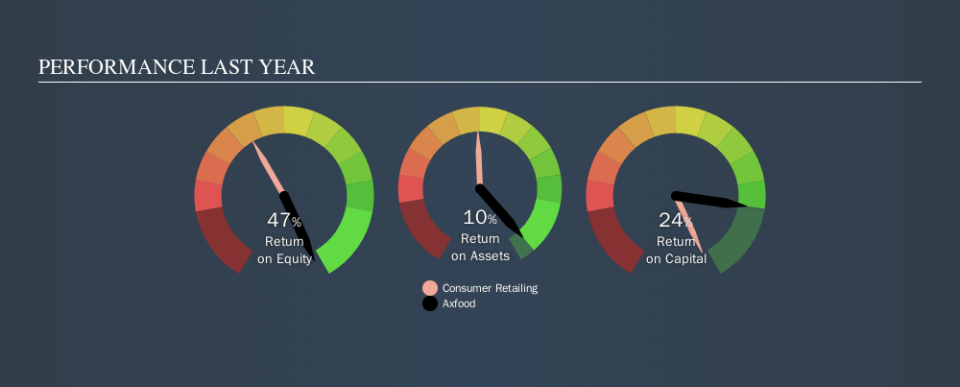Axfood AB (publ) (STO:AXFO) Earns A Nice Return On Capital Employed

Today we'll evaluate Axfood AB (publ) (STO:AXFO) to determine whether it could have potential as an investment idea. Specifically, we'll consider its Return On Capital Employed (ROCE), since that will give us an insight into how efficiently the business can generate profits from the capital it requires.
First of all, we'll work out how to calculate ROCE. Then we'll compare its ROCE to similar companies. Last but not least, we'll look at what impact its current liabilities have on its ROCE.
What is Return On Capital Employed (ROCE)?
ROCE is a metric for evaluating how much pre-tax income (in percentage terms) a company earns on the capital invested in its business. In general, businesses with a higher ROCE are usually better quality. Overall, it is a valuable metric that has its flaws. Author Edwin Whiting says to be careful when comparing the ROCE of different businesses, since 'No two businesses are exactly alike.
How Do You Calculate Return On Capital Employed?
Analysts use this formula to calculate return on capital employed:
Return on Capital Employed = Earnings Before Interest and Tax (EBIT) ÷ (Total Assets - Current Liabilities)
Or for Axfood:
0.24 = kr2.1b ÷ (kr17b - kr8.0b) (Based on the trailing twelve months to June 2019.)
So, Axfood has an ROCE of 24%.
Check out our latest analysis for Axfood
Is Axfood's ROCE Good?
ROCE is commonly used for comparing the performance of similar businesses. In our analysis, Axfood's ROCE is meaningfully higher than the 8.9% average in the Consumer Retailing industry. I think that's good to see, since it implies the company is better than other companies at making the most of its capital. Putting aside its position relative to its industry for now, in absolute terms, Axfood's ROCE is currently very good.
Axfood's current ROCE of 24% is lower than its ROCE in the past, which was 43%, 3 years ago. So investors might consider if it has had issues recently. The image below shows how Axfood's ROCE compares to its industry, and you can click it to see more detail on its past growth.
When considering this metric, keep in mind that it is backwards looking, and not necessarily predictive. ROCE can be deceptive for cyclical businesses, as returns can look incredible in boom times, and terribly low in downturns. This is because ROCE only looks at one year, instead of considering returns across a whole cycle. Since the future is so important for investors, you should check out our free report on analyst forecasts for Axfood.
Do Axfood's Current Liabilities Skew Its ROCE?
Short term (or current) liabilities, are things like supplier invoices, overdrafts, or tax bills that need to be paid within 12 months. Due to the way the ROCE equation works, having large bills due in the near term can make it look as though a company has less capital employed, and thus a higher ROCE than usual. To check the impact of this, we calculate if a company has high current liabilities relative to its total assets.
Axfood has total assets of kr17b and current liabilities of kr8.0b. As a result, its current liabilities are equal to approximately 47% of its total assets. Axfood has a medium level of current liabilities, boosting its ROCE somewhat.
What We Can Learn From Axfood's ROCE
Still, it has a high ROCE, and may be an interesting prospect for further research. There might be better investments than Axfood out there, but you will have to work hard to find them . These promising businesses with rapidly growing earnings might be right up your alley.
I will like Axfood better if I see some big insider buys. While we wait, check out this free list of growing companies with considerable, recent, insider buying.
We aim to bring you long-term focused research analysis driven by fundamental data. Note that our analysis may not factor in the latest price-sensitive company announcements or qualitative material.
If you spot an error that warrants correction, please contact the editor at editorial-team@simplywallst.com. This article by Simply Wall St is general in nature. It does not constitute a recommendation to buy or sell any stock, and does not take account of your objectives, or your financial situation. Simply Wall St has no position in the stocks mentioned. Thank you for reading.

 Yahoo Finance
Yahoo Finance 
